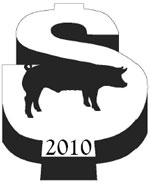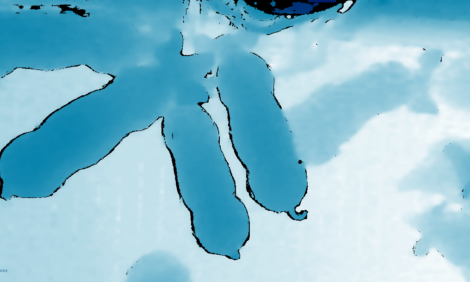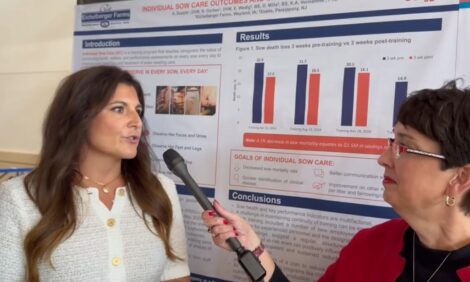



Iodine Value and its Impact on Pork Quality
Joel DeRouchey, Mike Tokach, Steve Dritz, Bob Goodband and Jim Nelssen of Kansas State University explain how 'pork quality' may be quantified in terms of the iodine value of carcass fat. Their paper was presented at the Swine Profitability Conference 2010.
Introduction
The term 'pork quality' is used in a very general sense when describing various attributes of a pig carcass. Historically, loin pH and sensory traits, drip loss, and color scores have been most widely used to describe 'pork quality'. At the same time, fat depot composition and color received less emphasis compared to loin attributes.
More recently however, processors have put more emphasis on carcass fat quality as a measure of 'pork quality'. Some of the reasons for this include export market acceptance, which requires ideal colour and firmness, fresh pork shelf life and the slice ability of bellies for bacon, which are affected negatively if the carcass fat becomes too unsaturated or 'soft'. In order to quantify 'pork quality' as it relates to carcass fat composition, researchers and processors have focused on determining the iodine value of carcass fat.
What is Iodine Value?
Iodine value is a measurement to estimate the amount of unsaturation present in the fatty acids present in carcass fat. Since unsaturated fatty acids are 'softer' or less firm, iodine value can be used as indicator of overall carcass fat firmness. Iodine value can be measured by three different methods. First, direct laboratory analysis that involves iodine binding to unsaturated or double bonds in fatty acids; thus a greater amount of iodine will bind to a sample that has a greater proportion of unsaturated fatty acids (AOCS, 1998). This process is the true chemical analysis procedure for determining iodine value.
However, due to the skill and time required to complete the lab analysis, this procedure has not been widely used. The results of iodine value are reported on a 'grammes per 100g' basis, with a lower value indicating a more saturated fatty acid composition, which is considered more ideal. Second, iodine value can be calculated from a fatty acid analysis where:
Iodine value = [C16:1] × 0.95 + [C18:1] × 0.86 + [C18:2] × 1.732 + [C18:3] × 2.616 + [C20:1] × 0.785 + [C22:1] × 0.723
where the brackets indicate concentration (percentage) of the fatty acid (AOCS, 1998). This approach has been widely used by researchers to determine carcass fat iodine and can be done easily after the fatty acid composition has been determined for a fat depot. Finally, near-infrared analysis (NIR) can be used to determine iodine value. Some processors are utilizing this method as it is the most rapid method for determining iodine value results. However, the precise calibration of the NIR machine is essential to accurately determine the iodine value of the carcass fat sampled.
What is an Acceptable Carcass Fat Iodine Value?
A limited amount of research has indicated that the maximum acceptable iodine value should be 70g per 100g (Barton-Gade, 1987; Madsen et al., 1992) or 75g per 100 g (Boyd et al., 1997). The true concern of swine processors regarding 'softer' carcasses do vary in the United States which impacts the ideal iodine value for different producers. Currently, some packing plants have set their maximum iodine value at 73g per 100g. Other plants do not specify a maximum iodine value; rather have specific recommendations for maximum use of certain ingredients, such as a maximum DDGS in late finishing diets. Thus, dietary strategies that different producers can utilize will vary depending on the processing plant pigs are marketed.
How Can Carcass Fat Iodine Value be Altered?
When fatty acids are absorbed from the diet, especially polyunsaturated fatty acids, they specifically inhibit endogenous synthesis of fatty acids. This effect then inflates the effect of dietary fat composition influencing body fat composition. Therefore, it is possible to manipulate the composition of body fat quite dramatically by selection of dietary fats (Pettigrew and Esnaola, 2001). Because most common dietary fats are more unsaturated than the triglycerides the pig synthesises endogenously, this can also lead to increased softness of carcass fat.
It is well documented that carcass fat composition is affected by the dietary ingredients and the composition of fatty acids that are fed (Averette Gatlin et al., 2002; Benz, 2008; Apple et al., 2009). Formulating diets that contain more unsaturated fat from fat sources, such as soy oil, yellow grease or animal-vegetable blends or from ingredients such as DDGS, bakery or full-fat soybean meal, will increase the unsaturation of the carcass fat. When carcass fat becomes more unsaturated, it becomes more flexible and termed 'softer'. Also, feeding more saturated fat sources, such as choice white grease will also increase iodine value, but at a much smaller degree.
In the review of feeding DDGS to swine, Stein and Shurson (2009) summarised data from eight trials that evaluated carcass fat iodine value, in which seven trials showed an increase in iodine value and one trial reported no change in iodine value. As a rule of thumb based on available data, carcass fat iodine value increases 2g per 100g for every 10 per cent DDGS that is fed throughout finishing. Thus, if the baseline of a herd fed a corn-soybean meal-based diet has an iodine value of 66g per 100g, pigs fed 30 per cent DDGS would have an estimated carcass fat iodine value of 72g per 100g.
Also, to determine the effect of different added fat sources, Benz (2008) fed pigs either a control corn-soybean meal diet, or diets with five per cent choice white grease or soybean oil from 97 to 285lb, and reported jowl fat iodine values of 63.3, 68.8 and 84.3g per 100g, respectively. Apple et al. (2009) evaluated feeding a control diet, or diets with five per cent tallow, poultry fat or soybean oil from 62 to 250lb. They reported carcass iodine values of 65.2, 64.7, 69.0 and 78.8g per 100g, respectively. These data further demonstrate the impact of dietary fat source and its impact on carcass fatty acid composition.
Research has also shown that cereal grain type can alter the carcass iodine value. Lampe et al. (2006) reported that pigs fed barley had reduced iodine values compared to pigs fed corn (58.7 versus 61.8). Furthermore, Benz (2008) reported that pigs fed milo had reduced carcass fat iodine values then pigs fed corn (68.3 versus 70.3g per 100g).
Pigs fed Paylean at 9g per ton 35 days prior to slaughter have been shown to have increased backfat iodine value than pigs not fed Paylean (Apple et al., 2009; 75.5 versus 72.7g per 100g). However, Duttlinger et al. (2009) reported that pigs fed Paylean at 6.75g per ton for 28 days prior to slaughter did not have different backfat iodine values than pigs not fed Paylean (68.4 versus 68.1g per 100g). Reasons for this conflict of data may be due to higher feeding levels and longer durations by Apple et al. (2009) compared to Duttlinger et al. (2009).
Does Iodine Value Change Based on Fat Depot Location on the Carcass?
The iodine value of carcass fat does change by depot location. Benz (2008) reported in three separate experiments that jowl fat was 4.5, 1.1 and 2.4 g/ 100 g higher than found in backfat. Thus, location of where the fat depot is selected for analysis can influence the iodine value reported. Currently, most packers are utilising fat form the jowl as the point of measurement due to ease of collection and prevention of loin damage from trimming backfat.
What Factors Other Than Dietary Composition Affect Iodine Value?
Research evaluating gender differences has been inconsistent in demonstrating differences in iodine value. Benz (2008) reported in two studies that gilts had a 1.5 and 0.7g per 100g increase in carcass iodine value in jowl fat compared to barrows, but in a third study found that gilts had a decreased jowl iodine value of 0.40g per 100g compared to contemporary barrows.
While no data is available on pig health status, fields observations have reported that health challenged pigs will have higher iodine values than contemporary healthy pigs. The mechanism for this observation effect is unknown and needs research to determine the true effect of health on final carcass iodine value.
Can Iodine Values be Predicted by Dietary Composition?
Madsen (1992) and Boyd et al. (1997) developed equations to predict backfat iodine from calculating a dietary iodine value product (IVP). Iodine value product is calculated as:
Iodine value product = (IV of the dietary lipids) × (percentage dietary lipid) × 0.10
However, Benz (2008) was unable to validate the dietary iodine value product with the actual carcass iodine values when using these equations when they fed various diets that were formulated with different fat and ingredient sources in combination. More research needs to be completed to accurately predict dietary feeding levels and duration of feeding various ingredients to predict final carcass fat iodine value.
However, nutritionists are becoming more comfortable with setting ingredient levels to match the required carcass fat iodine value. The key to predicting the iodine value accurately is having the actual farm baseline fed known diets throughout finishing and the resulting carcass fat iodine value. Once this is known, changes to dietary ingredients can be used to alter the value with some degree of confidence.
Summary
Iodine value is an indirect measure of carcass fat firmness and is directly impacted by the level of unsaturated fatty acids in the diet. More research is needed to accurately predict carcass iodine value when using various dietary ingredients containing different levels of saturated and unsaturated fatty acids. Also, depending on specific packer specifications, some producers must monitor carcass iodine values, while others who market to processors who do not measure or monitor iodine values are not impacted.
References
AOCS. 1998. Official Methods and Recommended Practices of the AOCS. 5th ed. Am. Oil. Chem. Soc., Champaign, IL.
Apple, J.K., C.V. Maxwell, D.L. Galloway, C.R. Hamilton and J.W.S. Yancey. 2009. Interactive effects of dietary fat source and slaughter weight in growing-finishing swine: III. Carcass and fatty acid compositions. J. Anim. Sci. 87: 1441-1454.
Averette Gatlin, A., M.T. See, J.A. Hansen, D. Sutton and J. Odle. 2002. The effects of dietary fat sources, levels, and feeding intervals on pork fatty acid composition. J. Anim. Sci. 80:1606–1615.
Barton-Gade, P.A. 1984. Some experience on measuring the quality of pork fat. In: J.D. Wood (ed.) Meat Research Institute, Special Rep. No. 2. In: Proc. CEC Workshop on Fat in Lean Pigs. Brussels. pp 47–52.
Benz, J.M. 2008. Influence of dietary ingredient on pork fat quality. MS Thesis. Kansas State University, Manhattan.
Boyd, R.D., M.E. Johnston, K. Scheller, A.A. Sosnicki and E.R. Wilson. 1997. Relationship between dietary fatty acid profile and body fat composition in growing pigs. PIC Technical Memo 153. PIC, Franklin, KY.
Duttlinger, A.W., J.M. DeRouchey, M.D. Tokach, S.S. Dritz, J.L. Nelssen, R.D. Goodband, T.A. Houser, K.J. Prusa and L. Huskey. 2009. Effects of crude glycerol and ractopamine HCl on growth performance, carcass characteristics, and loin quality of finishing pigs. J. Anim. Sci. 87 (Suppl. 2): (Abstr.).
Lampe, J.F., T.J. Baas and J.W. Mabry. 2006. Comparison of grain sources for swine diets and their effect on meat and fat quality traits. J. Anim. Sci. 84:1022-1029.
Madsen, A., K. Jakobsen and H. Mortensen. 1992. Influence of dietary fat on carcass fat quality in pigs. A review. Acta. Agric. Scand. 42:220-225.
Pettigrew, J.E., and M.A. Esnaola. 2001. Swine nutrition and pork quality: A review. J. Anim. Sci. 79(E. Suppl.):E316–E342.
Stein, H.H. and G.C. Shurson. 2009. BOARD-INVITED REVIEW: The use and application of distillers dried grains with solubles in swine diets. J. Anim. Sci. 87: 1292-1303.
Further Reading
| - | You can view other papers presented at the Kansas Swine Profitability Conference 2010 by clicking here. |
December 2010







